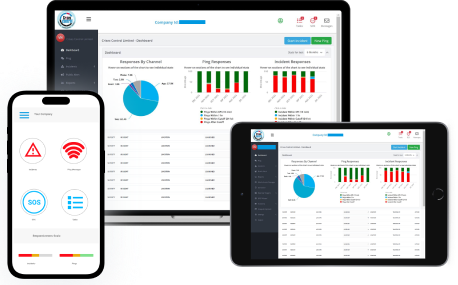In an unpredictable world, where unforeseen events can disrupt the normal flow of operations, having robust emergency communication systems is not just a prudent decision; it’s a strategic imperative. Crises Control’s cutting-edge platform empowers organisations to navigate crises seamlessly, ensuring that they emerge stronger on the other side. This blog will explore the essence of emergency communication systems, explore the benefits they bring, and shed light on why Crises Control stands out as the ideal solution in this critical domain.
Understanding Emergency Communication Systems
Emergency communication systems play a pivotal role in ensuring swift and effective communication during crises, be it natural disasters, cyber threats, or other unforeseen events.
These systems are designed to facilitate seamless information dissemination, enabling organisations to respond promptly, safeguard their assets, and protect their most valuable resource – their people.
The Components of Effective Emergency Communication Systems
1. Integration of Various Communication Channels
Robust emergency communication systems should integrate multiple communication channels such as SMS, email, voice calls, and push notifications. Crises Control excels in this aspect, providing a comprehensive suite of communication tools that cater to diverse needs.
2. Real-time Alerting
Instantaneous communication is non-negotiable during emergencies. Crises Control ensures real-time alerting, allowing organisations to disseminate critical information within seconds, reducing response time and potential damage.
3. Two-way Communication
An effective system must facilitate two-way communication, allowing stakeholders to respond, report, and seek assistance promptly. Crises Control’s platform promotes interactive communication, fostering a collaborative and informed approach during crises.
Crises Control’s Emergency Communication System

Now that we’ve established the importance of emergency communication systems, let’s explore why Crises Control stands out in this dynamic landscape.
1. Swift Incident Response
In the chaotic landscape of a crisis, response time is crucial. Crises Control acts as a catalyst for quick and decisive action by providing a centralised platform. This platform facilitates real-time communication, enabling organisations to reach their employees, stakeholders, and response teams instantly. Whether it’s a natural disaster, a cybersecurity breach, or any unforeseen event, the ability to disseminate critical information swiftly ensures a more coordinated and effective response.
2. Customised Communication Plans
Traditional, one-size-fits-all communication strategies often fall short in the realm of crisis management. Crises Control understands the need for tailored approaches and allows organisations to create customised communication plans. This flexibility ensures that the communication strategy aligns with the specific nuances of each crisis scenario.
By delivering the right message to the right audience at the right time, organisations can enhance their crisis communication efficacy, fostering a more targeted and impactful response.
3. Automated Workflows
In the heat of a crisis, the last thing organisations need is the burden of manual processes. Crises Control streamlines crisis management with automated workflows.
By automating routine tasks and communication processes, the platform minimises the need for manual intervention. This not only saves precious time, but also allows organisations to allocate resources strategically. Teams can focus on critical decision-making rather than getting bogged down by administrative tasks, leading to a more efficient and effective crisis response.
4. Secure Information Sharing
Amidst a crisis, maintaining the confidentiality and integrity of information is paramount. Crises Control places a strong emphasis on security by employing robust encryption and security measures. These safeguards ensure that sensitive information is shared securely within the designated audience.
In an age where data breaches are a constant threat, having a secure platform for information sharing during crises builds trust and confidence among stakeholders, allowing organisations to navigate through challenges with greater assurance.
5. Centralised Communication Platform
Crises Control’s centralised communication platform acts as the nerve centre during crises, bringing together all communication channels and stakeholders under one unified umbrella.
Centralisation is the linchpin for effective crisis management. By consolidating communication in a single platform, organisations can ensure that vital information reaches the right people in real-time. This streamlining of communication processes facilitates quick decision-making and coordinated responses, essential components when navigating through the complexities of a crisis. It eliminates the risk of information silos and promotes a cohesive, synchronised effort to address the situation at hand.
6. Comprehensive Communication Tools
Crises Control goes beyond the ordinary by integrating a spectrum of communication tools, spanning SMS, email, voice calls, and push notifications. In a crisis, diversity is key. The comprehensive suite of communication tools allows organisations to tailor their messaging to the preferences and habits of their audience.
Whether it’s reaching employees on the go with SMS or ensuring detailed information through email, this versatility enhances the reach and impact of crisis communication efforts. By leveraging a variety of channels, organisations maximise the likelihood that their messages will be received and acted upon promptly.
7. Adaptable to Unique Organisational Needs
Crises Control’s adaptability is a cornerstone feature, recognising that each organisation faces distinctive challenges and requirements. One size doesn’t fit all, especially in crisis communication.
Crises Control’s adaptability allows organisations to tailor their approach based on their specific needs and circumstances. Whether it’s different communication protocols, response workflows, or audience segmentation, the platform can be moulded to suit the unique demands of each organisation. This customisation ensures that crisis communication strategies are not only effective, but also aligned with the intricacies of the organisation’s structure and operations.
8. User-Friendly Interface
Crises Control prides itself on offering an intuitive and user-friendly interface. The simplicity of the interface is a game-changer in crisis communication management.
A user-friendly design reduces the learning curve, enabling organisations to swiftly adopt and integrate the platform into their operations. This accessibility ensures that even during high-stress situations, users can navigate the platform effortlessly, maximising its effectiveness in real-time decision-making and communication.
9. Audit Trails for Accountability
Crises Control provides robust audit trails, offering a comprehensive record of communication activities. Accountability is paramount in crisis management.
The audit trails offered by Crises Control provide a transparent and traceable history of communication processes. This feature allows organisations to review, analyse, and learn from past crisis responses, fostering continuous improvement. It ensures that accountability remains a constant focus, contributing to the overall effectiveness and reliability of the crisis management strategy.
Experience the Crises Control Advantage
Crises Control’s emergency communication system is your shield against the unexpected. Our comprehensive platform delivers real-time alerts, customizable plans, automated workflows, and secure information sharing – all within a user-friendly interface. It’s the power to amplify your voice in chaos, navigate any storm with confidence, and emerge stronger on the other side. As an expert in the field of emergency communication systems, we invite you to experience the Crises Control advantage firsthand.
Silence is deadly in a crisis. Emergency communication systems are your lifeline, ensuring swift alerts, real-time updates, and coordinated responses. Think minimised damage, streamlined workflows, secure information sharing, and a centralised platform for clear communication – all crucial for navigating any storm. Don’t wait for disaster to strike. Invest in preparedness with a robust emergency communication system. Your organisation, and its people, deserve it. Contact us now to schedule a free demo and discover how Crises Control can transform your organisation’s crisis communication strategy.
FAQs
1. What is an emergency communication system, and why do organisations need one?
An emergency communication system is a comprehensive platform that facilitates rapid and effective communication during crises, ensuring timely dissemination of critical information. Organisations need such systems to minimise response time, protect assets, and safeguard their most valuable resource – their people.
2. How does Crises Control differ from other emergency communication systems?
Crises Control sets itself apart through its integrated and customisable communication tools. It excels in real-time alerting, two-way communication, and automated workflows. The platform’s ability to adapt to specific organisational needs makes it a leader in the field.
3. How can Crises Control help in creating customised communication plans?
Crises Control allows organisations to create tailored communication plans for specific scenarios. This customisation ensures that the right message reaches the right audience at the right time, optimising crisis response strategies.
4. Why is swift incident response crucial in crisis management, and how does Crises Control address this need?
Swift incident response is crucial as it minimises the impact of crises. Crises Control addresses this need by providing a centralised platform for real-time communication, ensuring that organisations can respond promptly and efficiently to unfolding situations.
5. How does Crises Control prioritise the security of information during crises?
Crises Control prioritises information security through robust encryption and stringent security measures. By ensuring the secure sharing of sensitive information within the designated audience, the platform provides a trustworthy environment for organisations to manage crises confidently.








